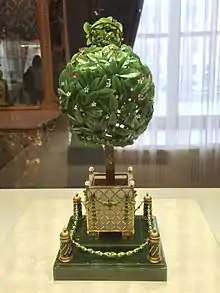Bay Tree (Fabergé egg)
The Bay Tree egg (also known as the Orange Tree egg) is a jewelled nephrite and enameled Fabergé egg made under the supervision of the Russian jeweller Peter Carl Fabergé in 1911,[1] for Nicholas II of Russia who presented the egg to his mother, the Dowager Empress Maria Feodorovna, on 12 April 1911.[2]
| Bay Tree Fabergé egg | |
|---|---|
 | |
| Year delivered | 1911 |
| Customer | Nicholas II |
| Recipient | Maria Feodorovna |
| Current owner | |
| Individual or institution | Viktor Vekselberg Fabergé Museum in Saint Petersburg, Russia |
| Year of acquisition | 2004 |
| Design and materials | |
| Materials used | Gold, green and white enamel, nephrite, diamonds, rubies, amethysts, citrines, pearls and white onyx |
| Height | 273 millimetres (10.7 in) when closed, 300 millimetres (12 in) when opened |
| Surprise | Feathered songbird |
Its 1911 counterpart, presented to the Empress, is the Fifteenth Anniversary egg.
Surprise
Turning a tiny lever disguised as a fruit, hidden among the leaves of the bay tree, activates the hinged circular top of the tree and a feathered songbird rises and flaps its wings, turns its head, opens its beak and sings.[1]
History
Based on an 18th-century French mechanical orange tree,[3] it was incorrectly labeled as an orange tree for some time, but was confirmed as a bay tree after the original invoice from Fabergé was examined. Fabergé charged 12,800 rubles for the egg.[1]
In 1917, the egg was confiscated by the Russian Provisional Government and moved from the Anichkov Palace to the Kremlin.[1] It was sold to Emanuel Snowman of the jewellers Wartski around 1927.[1]
In 1934, Wartski sold it to Allan Gibson Hughes for £950, buying it back from his estate in 1939 after his death. The egg has a fitted case inscribed with the initials A. G. H. which is probably attributable to this period of ownership.[4]
In 1947, it was sold by Sotheby's in London for £1,650 and then passed through several different owners, ending with Mrs. Mildred Kaplan. She sold it to Malcolm Forbes in 1965 for $35,000, equivalent to $212,634 at the time of the 2004 sale of the Forbes Collection to Viktor Vekselberg. Vekselberg purchased some nine Imperial eggs, as part of the collection, for almost $100 million [5]
The egg is now part of the Victor Vekselberg Collection, owned by The Link of Times Foundation and housed in the Fabergé Museum in Saint Petersburg, Russia.
See also
References
- "Faberge - Treasures of Imperial Russia". Archived from the original on 2007-07-28. Retrieved 2007-11-28.
- Mieks Fabergé Eggs
- Faberge Eggs - outrageous opulence
- Lowes, Will; McCanless, Christel Ludewig (2001). Fabergé Eggs: A Retrospective Encyclopedia. ISBN 9780810839465.
- Energy Tribune Archived 2007-11-14 at the Wayback Machine
Sources
- Faber, Toby (2008). Faberge's Eggs: The Extraordinary Story of the Masterpieces That Outlived an Empire. Random House. ISBN 978-1-4000-6550-9.
- Forbes, Christopher; Prinz von Hohenzollern, Johann Georg (1990). FABERGE; The Imperial Eggs. Prestel. ASIN B000YA9GOM.
- Lowes, Will (2001). Fabergé Eggs: A Retrospective Encyclopedia. Scarecrow Press. ISBN 0-8108-3946-6.
- Snowman, A Kenneth (1988). Carl Faberge: Goldsmith to the Imperial Court of Russia. Gramercy. ISBN 0-517-40502-4.
| Wikimedia Commons has media related to Bay Tree (Fabergé egg). |
